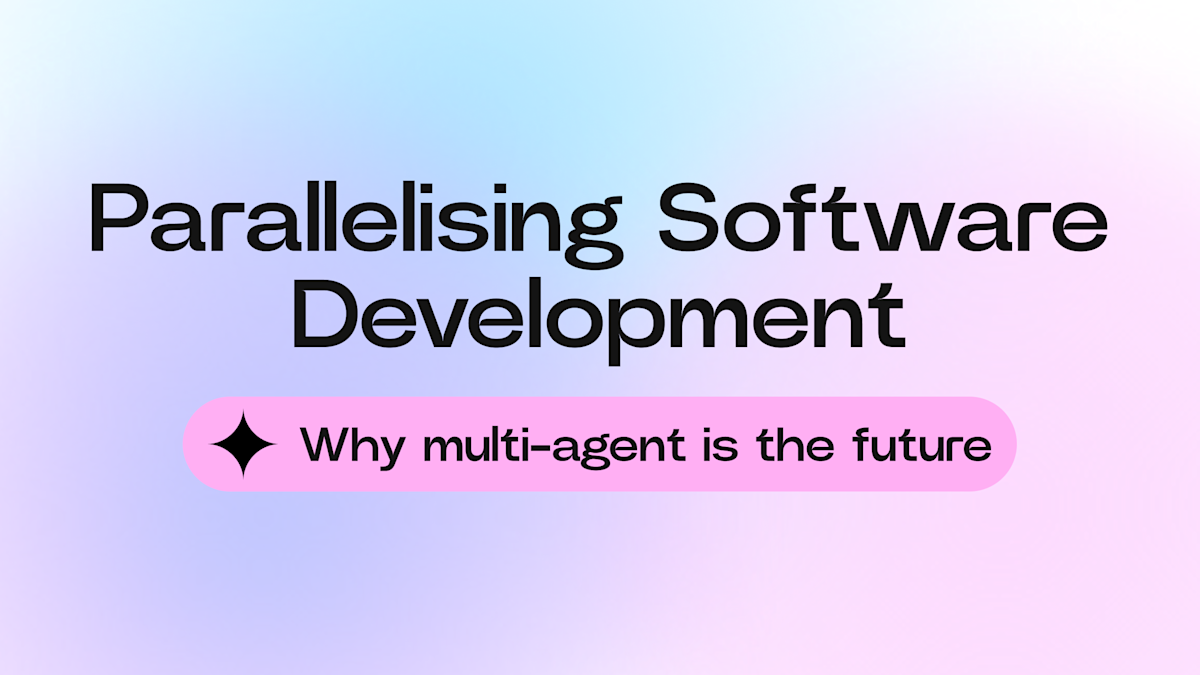Software engineering is at a turning point. AI coding assistants like GitHub Copilot autocomplete and suggest functions, and early surveys reported up to 20% productivity gains. But that’s incremental. Even with faster typing, engineers still work serially, and over half the day goes to non-coding work like debugging, reviews, incidents, and meetings. A 20% coding speed-up doesn’t translate to 20% overall productivity.
To leap not 20%, but 3-5×, we have to change how work happens: parallelise it. Imagine one engineer orchestrating a fleet of AI agents to tackle many tasks at once. That’s the vision behind agentic AI engineers like Cosine’s platform. By turning a developer into a team lead for dozens of AI “colleagues,” we shift from serial effort to parallel throughput. This post explores how multi-agent workflows can multiply output, freeing humans to focus on the highest-value work while AI handles the rest.
The limits of first-generation AI coding tools
The first wave of AI coding assistants, like GitHub Copilot, Tabnine, and Amazon CodeWhisperer, has been a game-changer, but with clear limits. These tools autocomplete and suggest code in real time, helping developers work faster. Studies show Copilot users complete tasks up to 55% faster.
Yet these improvements are incremental. The workflow remains the same: a human still codes and reviews each change, just with a quicker helper. Even if a function takes five minutes instead of ten, you’re still completing one task at a time. And since coding is only part of the job, developers spend about 57% of their time firefighting bugs and issues, and speeding up code writing barely moves overall timelines.
Even advanced tools like Cursor, an AI-powered IDE, remain bound to a single engineer’s workflow. They automate parts of the process but still operate serially – one developer, one task, one project at a time.
In short, current AI coding tools are like having a faster typist or a knowledgeable assistant at your side – helpful, but constrained. They accelerate the act of coding itself, which yields at best a fractional boost in end-to-end software delivery speed. As long as an engineer is working serially, tackling tickets one after another, there’s a hard ceiling on productivity gains. To break through that ceiling, a different approach is needed.
Beyond autocomplete with autonomous engineering agents
What if AI could take on entire development tasks, not just suggest the next line of code? That question sparked a new wave of autonomous coding agents – AI systems designed to act like developer colleagues who can take a high-level goal and deliver working code with minimal supervision.
In March 2024, startup Cognition introduced Devin, an AI software engineer built on OpenAI’s GPT-4, that could write and edit code given natural language instructions. Devin proved that AI could act as an independent contributor, not just a code suggester.
Five months later, Cosine leapfrogged the field with Genie, trained to think and behave like a human software engineer. Genie outperformed Devin and other models on the SWE-Bench benchmark and, more importantly, was built to work with teams, not as a copilot, but as a peer. As our co-founder, Alistair Pullen, explains: “Genie can solve bugs, build features, refactor code, and everything in between – either autonomously or paired with the user, like a colleague, not just a copilot.”
These autonomous agents handle much more of the software development lifecycle on their own. They don’t just write a snippet and hand it back; they can clarify requirements, break down a problem, write and test code, iterate on feedback, and produce a final solution. For instance, Genie – now Cosine – will ask clarifying questions if the task is ambiguous, decompose high-level tickets into subtasks, generate code for each part, run tests or static analyses, and finally open a polished pull request for the human to review. The goal is a PR that’s structured, documented, and ready to merge, without the need for micromanagement. In essence, these AI agents behave like a competent junior engineer who can take a ticket from “to-do” to “done”.
This shift marks what MIT Technology Review calls “the second wave of AI coding.” From Google’s Gemini Code Assist to startups like Cosine, autonomous coding is spreading fast. By late 2024, over a quarter of Google’s new code was already generated by AI and reviewed by humans. AI is becoming a true team member, writing substantial code while engineers focus on oversight and direction.
Autonomous coding agents are a big leap forward, but we can push the idea even further. If a single AI agent can take one task off an engineer’s plate, what if we had dozens or hundreds of such agents working in tandem? This is where parallelisation enters the picture, unlocking the potential for exponential productivity gains.
Parallel workstreams, or turning one engineer into many
In traditional software projects, productivity scales linearly with team size: two engineers roughly double the output of one (minus coordination overhead), five can handle five tasks in parallel, and so on. Until recently, AI couldn’t replicate this effect because tools only enhanced a single developer’s speed. True autonomous agents change that. By running multiple agents at once, one engineer can now operate with the throughput of an entire team.
Take a simple example: five feature requests due this week. A solo engineer, even with a coding assistant, would handle them sequentially and finish by the week’s end. But with AI agents, that same engineer can delegate each ticket on Monday morning, and by the afternoon, five pull requests are ready for review. The human’s role becomes orchestrator and reviewer: specifying tasks, answering clarifications, and approving results. The agents handle the coding and testing in parallel. The outcome is a 5× productivity boost, something no single-agent model can achieve. Even a 50% faster coder could only do ~1.5× more work; five agents in parallel can deliver 5×.
This principle of parallelisation underpins Cosine’s platform. Engineers can assign multiple tickets at once, then come back to review and merge PRs. Cosine automatically breaks complex tasks into subtasks and spins up specialised agents to tackle them concurrently. If a new feature touches backend, database, and frontend layers, Cosine launches three agents – one for each – while the engineer stays in the loop through progress updates and can intervene anytime. This means engineers can deploy and manage multiple agents simultaneously, freeing them to focus on other work. It’s effectively a multi-threaded workflow for humans.
It’s like a tech lead overseeing a team of tireless junior developers, but without the coordination drag. AI agents share context fluidly, don’t wait for standups, and operate asynchronously at machine speed. From the human’s view, it’s like having an army of clones working through the backlog. The idea of infinite, on-demand developer capacity is no longer science fiction; it’s an emerging reality.
Even a handful of concurrent agents can compress timelines dramatically. Projects that once took a small team a month can now be completed in days by one engineer leveraging Cosine’s multi-agent system. Internal benchmarks show it outperforming single-agent models on complex, production-grade tasks, and early users report 3× or greater throughput gains. As this model spreads, we expect a step-change in engineering productivity, well beyond the modest 25% lifts of first-generation AI tools.
The engineer’s evolving role
Shifting to parallel AI-driven workflows doesn’t remove the human from the loop; it elevates them. Instead of writing every line of code, developers will define problems, guide AI agents, and validate solutions. The engineer becomes a project manager and quality controller for a fleet of AI coders. This new role brings both responsibility and leverage:
1) Requirements and vision
Humans remain best at interpreting product goals, user needs, and ambiguous specs. Engineers will spend more time defining high-level requirements and less on rote implementation. Cosine, for instance, proactively clarifies requirements through natural-language dialogue, but it’s the human who decides what should be built. Ensuring the AI tackles the right problem is central to the engineer-as-orchestrator role.
2) Oversight and quality assurance
Parallel agents still need review. Like a senior developer merging teammates’ pull requests, the human reviews AI-generated code, runs tests, and ensures each feature meets acceptance criteria. Agents such as Cosine already self-test and generate documented, production-ready code, but accountability for correctness remains with the human. Since review is far quicker than authoring code, one engineer can oversee many agents’ work within a normal schedule.
3) Creative problem solving
With routine coding delegated to AI, developers can focus on higher-value work – architecture, algorithm design, tricky edge cases, or user experience improvements. AI handles the boilerplate; humans handle the breakthroughs. This shift not only multiplies productivity but also makes the job more fulfilling (studies show AI assistance boosts developer satisfaction by removing repetitive work).
4) Coordination and communication
Supervising multiple agents, and often other humans, demands strong organisation. Engineers define task boundaries, manage dependencies, and integrate outputs. AI helps here too: Cosine’s multi-agent system automatically decomposes projects and tracks interdependencies, much like a tech lead assigning and syncing work across a team. Still, the human orchestrator must keep the big picture and adapt plans when needed.
The result
The engineer-as-orchestrator model dramatically increases leverage. A single developer, empowered by dozens of AI agents, can manage an entire product lifecycle, from design to deployment, without traditional scaling bottlenecks like hiring or onboarding. As our co-founder Alistair Pullen notes, an AI colleague that can “solve unseen problems in timeframes orders of magnitude quicker than a human” is immensely valuable. Multiply that by N instances on demand, and the usual constraints of engineering start to dissolve.
In practice, this means startups can achieve in weeks what once took large teams months, while enterprises can pursue many projects in parallel without ballooning headcount. Engineering capacity becomes a near-limitless, cloud-like resource; provisioned as needed, in the form of AI agents.
Bold visions and realistic steps forward
The vision of fully parallelised software engineering, powered by swarms of AI agents, is bold and transformative. Backlogs could vanish overnight, as automated developers handle routine work while humans focus on strategy, innovation, and polish. Investors have taken note: “second-wave” AI coding startups have reached unicorn status almost instantly. A 5x or 10x productivity jump could redefine delivery speed and reshape the talent equation. For engineers, it’s liberating; less drudgery, more creative engineering, and faster shipping.
But this future depends on reliability and trust. AI agents must be safe, accurate, and transparent. Key challenges remain:
Security and correctness – Keep human review as a failsafe – AI writes, humans merge.
Context sharing – Use long-context models and integrated knowledge bases; Cosine, for example, stays grounded in production code, synced with Slack, Jira, and Linear.
Cultural change – Teams must adapt workflows to orchestrate agents, not just individuals.
Early adopters are already seeing results. One Cosine pilot cleared dozens of bug tickets in a sprint – work that normally required a small team – while focusing on a major redesign. “It felt like we’d hired three extra engineers,” said the manager. Broadly, over 60% of AI-enabled teams report at least a 25% boost in velocity, but those using autonomous agents see far higher multiples.
Assistants make individuals faster; agents make teams exponentially faster.
Orchestrating as the future of engineering
For decades, we’ve searched for ways to make programmers more productive – from high-level programming languages to better development methodologies, to IDEs and open-source libraries. AI is the latest tool in our arsenal, and with the first generation of coding assistants, we saw only a hint of its potential. The next leap in engineering efficiency will come not from a smarter autocomplete, but from a fundamental shift in how work is allocated and executed. By parallelising workstreams with AI agents, we can break out of the one-developer-one-task bottleneck and enter an era of many-tasks-per-developer.
This shift transforms the role of the software engineer into something more powerful and strategic. It amplifies human creativity and decision-making with machine speed and scale. Imagine a world where a single engineer can oversee an “army” of AI devs building an entire product in a fraction of the time – that world is rapidly approaching. As we at Cosine like to say, why settle for an AI copilot when you can have a whole fleet of AI colleagues? The technology is here, the need is clear, and the productivity gains are simply too large to ignore.
Let’s orchestrate this future together and free ourselves to focus on the most important, human parts of engineering while our AI counterparts handle the rest. Interested in Cosine's solution? Start here.


 @PandelisZ
@PandelisZ 

